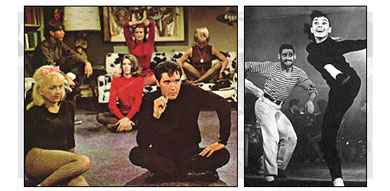Beats

Fashion Synopsis
“Don’t fret cat, its all bells. We got no bread baby, but that’s not our bag anyway. So dig the crazy scene and don’t be such a drag.” --the voice of the Beat Generation
The beats checked out of the idyllic life promised by 1950’s suburbia, making their home in the smoky jazz clubs of the urban utopia. They were the true rebels of conformity and bourgeois beliefs, rejecting the conventional lifestyle of middle-America for the hip, ‘beaten’ down way of life. They talked different, looked different, and were strange cats compared to everybody else. Rock and roll rebellion was one thing, but this… this far-out scene was unlike anything Mom and Dad had seen before.
Most beats were not military material, neither were they conformists ready to seek out the corporate world. They were free-thinkers like founders Allen Ginsberg, William S. Bourroughs and Jack Kerouac, all friends and writers. Beats submerged themselves in life—philosophy, poetry, art, music, politics and the road. Beat ‘godfather’ Jack Keroac wrote about their wanderings in the quintessential beat bible On the Road, and jazz musicians like Dizzy Gillespie contributed bebop slang as well as his trademark dark shades and beret.
Beats rejected the greaser style of t-shirt and jeans, as well as the square style of poodle skirts and saddle shoes. Instead, the boys wore sloppy joe sweaters and baggy chinos with leather huarachi sandals, while the ladies wore black leotards and straight skirts with sandals or ballet slippers.
Men let their hair grow longer, while women cut theirs short in the gamine or urchin cut. Berets topped everyone's crown, and silver jewelry from the Native American culture proved their sympathy for social causes. The beats’ dark fashions echoed the burdened psychological state they lived in—black became synonymous with chic, and angst was the best accessory.
The beat look was a non-conformist trend (how’s that for an oxymoron?), but that didn’t stop TV and movies from horning in on the style. Maynard G. Krebs’ beatnik style from The Many Loves of Dobie Gillis was beat-ish, featuring worn-in sweatshirt, sloppy chinos, and goatee, while Audrey Hepburn’s hepcat hipness in Funny Face was unforgettable—gamine haircut, black leotard and capri leggings with ballerina flats.
Ernest Hemingway had dubbed post-WWI the ‘Lost Generation,’ while this new league of literary loners of post-WWII became known as the ‘Beat Generation’. While they were beat, they certainly were not lost, and their riff foreshadowed the hippie promise of universal acceptance and brotherly love to come in the 60’s. They jived to the sound of the bongos, and it was heavy, man. Dig.
